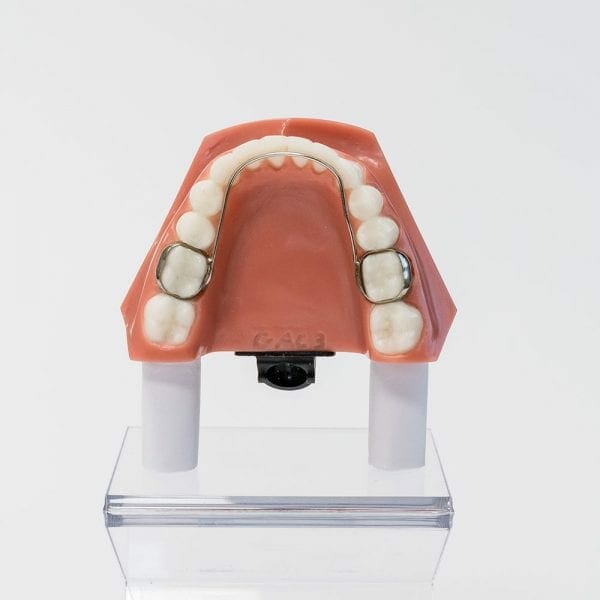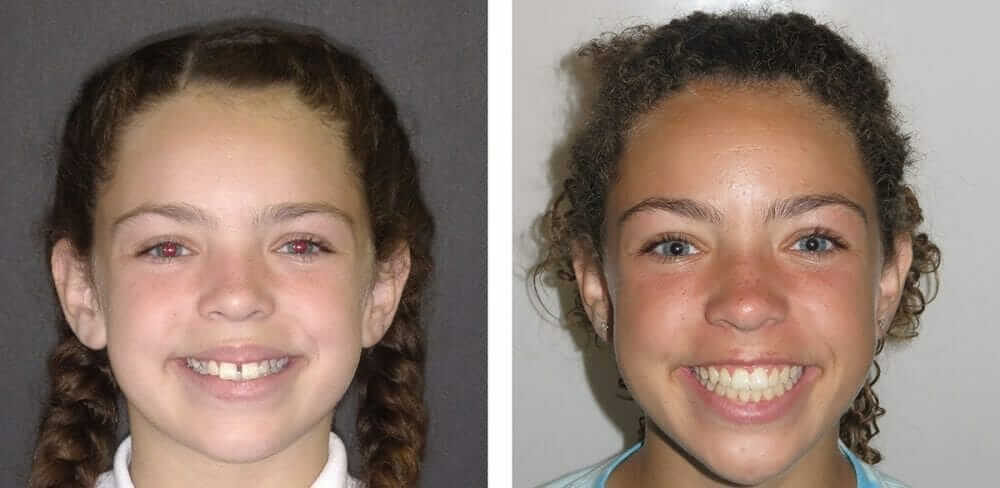What is a Lower Lingual Holding Arch?
A lower lingual holding arch is an orthodontic appliance that helps to maintain space in the mouth. A less technical term would be space maintainer.
When the terms are broken down individually, the meaning and use of the appliance become clearer.
- Lower means that the device is attached to the lower (or bottom) teeth. With this appliance, two stainless steel rings (called bands) are affixed to the first molars. A stainless steel wire then runs along the inside of the lower teeth to connect the bands.
- Lingual is the medical term for the tongue. This term is used because the wire that connects the two bands is placed on the “tongue” side of the lower teeth. This means that patients wearing the device can feel the connecting wire with their tongues.
- Holding refers to the device’s use in holding teeth in a particular position (such as preventing the bottom molars from moving forward and blocking adult teeth from erupting.)
- Arch is the dental term for the U-shaped structure that contains teeth, gum, and alveolar bone. Every person has two dental arches—an upper arch (maxillary) and a lower arch (mandibular). Most adults have 16 teeth in each arch, for a total of 32 permanent teeth.

When to Use a Lower Lingual Holding Arch
A lower lingual holding arch may be used for several reasons, including:
- Preventing lower molars from moving forward and blocking permanent teeth from erupting
- Acting as an anchor for elastics, which might be needed to stabilize and support molars while correcting an overbite
- Serving as a space maintainer, especially after the early loss of baby teeth
- Preserving “leeway space” before the baby molars have shed. Leeway space describes the discrepancy in size between the baby molars and the premolars that replace them (the baby molars are slightly bigger than the permanent premolars)
- Holding the lower molars in a favorable position to help with bite correction when the patient is older (Ie. when a patient has an underbite)
This appliance is most often used in young children who have not had all their adult (permanent) teeth erupt into the mouth yet. The device typically remains in the mouth until all permanent teeth have erupted. As stated above, the device is most often used to preserve space in the mouth after the early loss of baby teeth. It may also be used when the bottom teeth are overcrowded.

How Long Do Patients Wear a Lower Lingual Holding Arch?
The lower lingual holding arch usually remains in place until all of a patient’s adult teeth have erupted. This is why the device is referred to as a “space maintainer” as it reserves space in the mouth for the adult teeth to grow into. Because the device is used in younger children, it is often considered a Phase 1 orthodontic treatment device. (Phase 1 treatment is also referred to as interceptive orthodontics.)
The American Dental Association recommends that all children have an orthodontic screening by the age of 7. This allows an orthodontist to intervene early on to head off developing problems associated with teeth crowding, early loss of baby teeth, improper jaw growth, protruding front teeth, and bite issues (such as underbites and crossbites).
With Phase 1 treatment, serious problems can be corrected more easily—preventing more intense and longer treatment later on in life.
How is a Lower Lingual Holding Arch Fitted?
The lower lingual holding arch is a fairly uncomplicated device and each one is custom-made for a patient by our orthodontists. Impressions (conventional or digital) are taken first. Then, an orthodontic lab makes the device. The metal bands are affixed to the first molars with orthodontic adhesive. Once installed, the device is virtually invisible. Most patients do not experience any discomfort once the space maintainer is in place.
Patients may need a few days to get adjusted to the lower lingual holding arch. During the first few days, patients may experience the following.
- A slight speech impairment may occur. This is expected as the tongue adjusts to the device and will be back to normal in a couple of days. To help speed up the adjustment, patients are encouraged to talk out loud as often as possible once the space maintainer is installed.
- Extra saliva may be produced during the first few days. This is simply the mouth’s way of reacting to something new.
- Some patients may feel slight discomfort near the cheeks and tongue for one or two days. Using orthodontic wax and rinsing with warm salt water will help reduce any discomfort.

Maintenance and Care of the Lower Lingual Holding Arch
Care and maintenance of the lower lingual holding arch are straightforward and simple. Little maintenance is required by the patient. However, patients who play with the wire with their fingers or tongue could possibly break or loosen it. If the wire becomes loose on either side, please contact our office for an appointment. In the unlikely event that the bands move, patients should come into the office to get the bands reattached.
As far as cleaning the appliance, patients should do the following:
- Clean and brush with a toothbrush and toothpaste as usual.
- Use a proxy brush, floss threader, or water flosser to clean and remove any food around the wire and bands.
- Avoid chewy and sticky foods that might loosen or get stuck in the appliance. Patients should also avoid crunchy or hard foods (such as nuts, ice, and hard candy) to prevent breakage.
To learn more about interceptive orthodontics and whether your child may benefit from a device such as the lower lingual holding arch, contact Burke & Redford Orthodontists at (951) 699-8011 to schedule a free consultation. You can also complete the contact form on our website anytime.